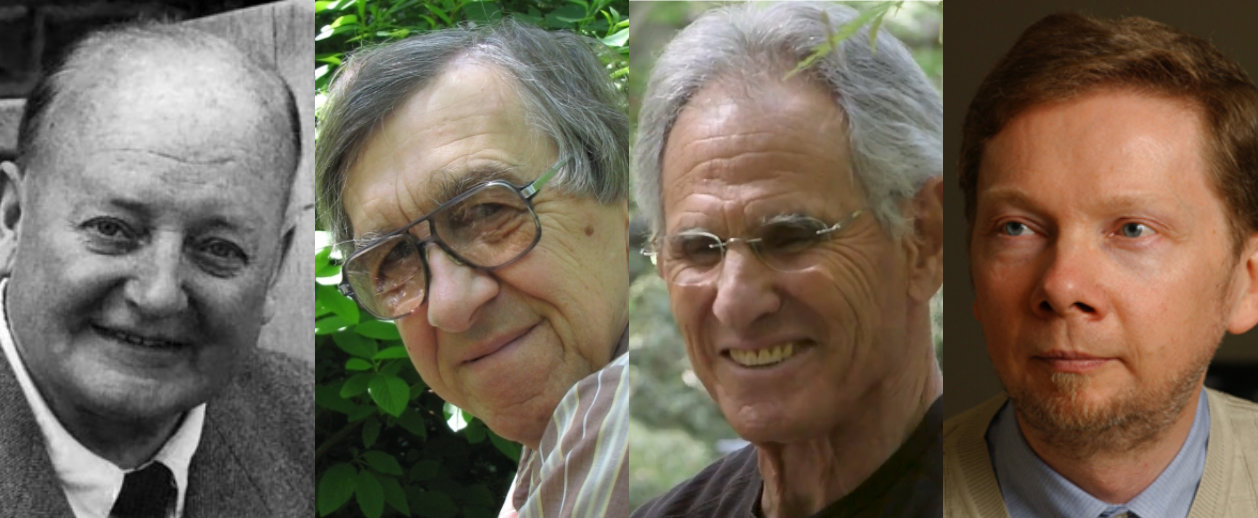
Before Eckhart Tolle popularised the “Power of Now,” other Western authors wrote about the present moment. Here are some comparisons with some of his precursors, which show clear similarities.
I’ve been tracing how esoteric currents from last century have shaped certain popular spiritual ideas today, looking at Eckhart Tolle’s work to examine these trends.
Tolle, perhaps the most famous independent spiritual teacher, is known for advocating being more conscious, aware or “present” in “the Now.”[1] While not the first westerner to contemporise such ideas, he has brought them to unparalleled popularity, reaching millions of people with “spiritual but not religious” outlooks.[2]
A basis for much of what he teaches can arguably be found in older traditions, but Tolle’s message finds most in common, I believe, with 20th century western sources, sharing distinctive features with them. My in-depth comparison of Eckhart Tolle’s work with Fourth Way teacher Dr Maurice Nicoll highlights many examples of this.
Below I’ve gathered the similarities about the spiritual importance of “the present moment” or “now” I’ve discussed previously, and arranged these in tables to bring them into focus. As well as some Nicoll-Tolle comparisons, included are comparisons of Tolle with Charles T. Tart and Jon Kabat Zinn. These commonalities, while raised before, were somewhat buried in longer articles on broader topics, and probably didn’t get the attention they deserved. Please note this collection is not exhaustive: it’s just some notable similarities I’ve personally uncovered in my research so far. There are other authors, not included here, who discuss this theme too it must be said.
Similar passages or phrases are presented side-by-side, so the authors’ words can be easily compared. Quoted text has been bolded or underlined in places to emphasise key commonalities; all italics are original to the source material.
Charles Tart and Eckhart Tolle
| Charles T. Tart | Eckhart Tolle |
| ‘One response to the deadness of everyday life . . . is to seek out danger. . . . In certain dangerous sports, for example, like skiing to the limit or auto racing, you must be present to the physical world. . . . You are forced to be present.’[3] | ‘The reason why some people love to engage in dangerous activities, such as mountain climbing, car racing, and so on, although they may not be aware of it, is that it forces them into the Now.’[4] |
| ‘If your attention lapses for two-tenths of a second, you may maim or kill yourself.’[5] | ‘Slipping away from the present moment even for a second may mean death.’[6] |
| Danger can force us to ‘feel more vital and alive.’[7] | This can force someone into ‘that intensely alive state.’[8] |
| ‘You can become more alive without having to put yourself . . . in mortal danger.’[9] | ‘But you don’t need to climb the north face of the Eiger. You can enter that state now.’[10] |
Jon Kabat-Zin and Eckhart Tolle
| Jon Kabat-Zin | Eckhart Tolle |
| Advocates ‘present-moment awareness’[14] | Advocates ‘present-moment awareness’[15] |
| ‘You are not your thoughts’[16] [17] | ‘You are not your mind’[18] |
| ‘Allow this moment to be exactly as it is’[19] | ‘Allow the present moment to be’ [20] |
| Have ‘acceptance of the present moment’ but not ‘resignation in the face of what is happening.’[21] | Have ‘acceptance of the Now’ but not ‘resignation’ in the face of ‘an undesirable or unpleasant life situation.’[22] |
| Suggests ‘bringing awareness to our breathing’ and ‘using the breath to bring us back to the present moment.’[23] | ‘Being aware of your breath forces you into the present moment. . . . Be aware of your breathing.’ [24] |
Maurice Nicoll and Eckhart Tolle
Most of my articles explore commonalities in the work of Fourth Way teacher Maurice Nicoll and Eckhart Tolle. These tables compare their views on the spiritual significance of “now.”
The now, time, eternity and the cross
| Maurice Nicoll | Eckhart Tolle |
| ‘Self-Remembering can give a feeling utterly different from . . . hurrying, anxious Time. Essence, being eternal, has not the feelings of Personality which are of Time only.’[26] | ‘In . . . the shift in consciousness from time to presence . . . the personality that has a past and a future momentarily recedes and is replaced by an intense conscious presence.’[27] |
| ‘Eternity is always in now and can be experienced as a different taste from Time. . . . Real ‘I’ is in Eternity—not in Time. Self-Remembering is out of Time and Personality.’[28] | ‘In that state, all your attention is in the Now…. The “you” that has a past and a future—the personality if you like—is hardly there anymore. And yet . . . you are more fully yourself.’[29] |
| ‘[Real] I dwells in now, and not in passing-time.’[30] | ‘It is only now that you are truly yourself.’[31] |
| ‘The horizontal line represents Time—the 4th dimension. The vertical lines represent the 5th dimension entering every moment. . . . Time and Eternity can be represented as the Cross.’[32] | ‘A few people have interpreted the Christian cross . . . as . . . showing the horizontal dimension of life, and suddenly it intersects with the vertical dimension.’[33] |
| ‘The diagram of the Cross as given represents a single moment in a man’s life. In this single moment the vertical line is cut across by the horizontal line of Time. . . . The point of intersection of the vertical with the horizontal line is now.’[34] | There’s the vertical dimension and the horizontal dimension. One could even say that the cross . . . symbolizes that also. . . . Most people only know the horizontal dimension, unaware of the vertical dimension which is . . . the present moment.[35] |
| ‘The vertical line is a line representing different levels of being. . . . A horizontal line, drawn at right angles . . . will represent a person’s life in Time.’[36] | ‘That spiritualization of who you are is the dimension of depth, the vertical dimension; what happens [in your life] is the horizontal dimension.’[37] [38] |
| ‘It is only this feeling of the existence and meaning of the direction represented by the vertical line that gives a man a sense of now.’[39] | ‘And so you enter the vertical dimension by being—becoming present, by bringing your attention into the now.’[40] |
| ‘The present moment is both in Time and in Eternity. It is the meeting-place of Time and Eternity. Eternity enters every present moment.’[41] | ‘Time is the horizontal dimension of Life. . . . The vertical dimension of depth [is] accessible to you only through the portal of the present moment.’[42] |
| ‘In a state of Self-Remembering . . . we feel Eternity. . . . At any moment . . . the dimension of Eternity enters and we may happen to become conscious of it.’[43] | ‘So . . . you go through life not just living on the surface of the horizontal dimension, but bringing the vertical into the horizontal.’[44] |
| ‘Eternity is vertical to Time—and this is . . . the feeling of oneself now. . . . To remember oneself the feeling of now must enter. . . . Eternity is always in now.’[45] | ‘Entering the vertical dimension requires a high degree of Presence. The Now needs to be the main focus of our attention.’[46] |
Concluding comments
Across a series of articles, I’ve already discussed many similarities Tolle’s work shares with Nicoll’s (and some major differences). I made these tables to present just some of these, plus those involving a few other authors I’ve mentioned along the way, in a format easier to digest. As I’ve said before, I think Tolle has popularised, with some changes, ideas which began crystallising in works published before his own. I think these tables help to show a part of that picture.
I’d not focused specifically on explicit references to the present moment or “now” in my previous comparative analysis, although this comes up indirectly on closely-related topics like self-observation (which can only be done in the present moment). So by compiling these tables I hope I’ve highlighted some interesting spiritual trends I’ve touched upon that are worthy of more attention.
However, I’m only summarising here what I’ve already covered, on these particular topics, in my own personal research: I’m not suggesting it encompasses a complete picture. Tolle has other influences too, and one important one I’ve written about previously is Barry Long, in an article on the “pain-body.” Their commonalities go beyond that concept though; Long, whose talks Tolle attended in the 80s, also taught about the now, as have others, such as Ram Dass.
(Since I published this article, Gavin Wilson, who attended Barry Long’s talks for many years, has released an essay discussing Long’s influence on Tolle and comparing aspects of their teachings. Wilson argues that Long’s earlier teachings on the Now, among other things, had an important impact on Tolle, and I’m inclined to agree. You can read his article on The Barry Long Foundation website.)
While I cannot highlight every particular similarity Tolle’s work shares with prior sources, I do hope to present enough to show there is a hidden history behind many of the ideas and expressions he has popularised.
I’ll share more comparison tables on other topics in future posts.

Leave a Reply